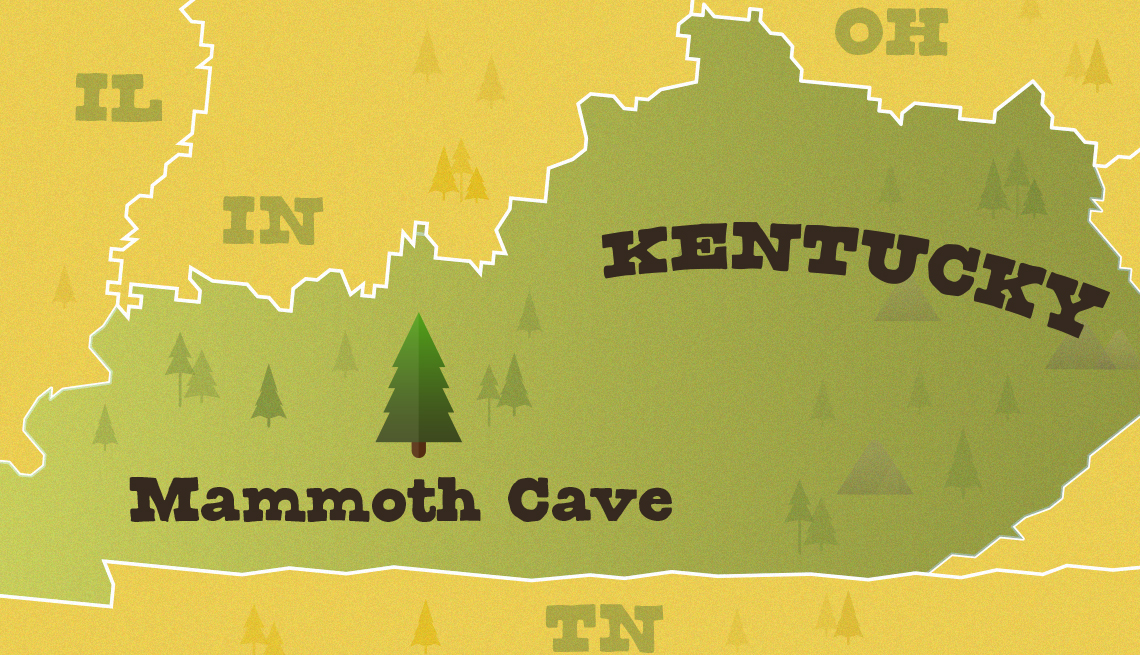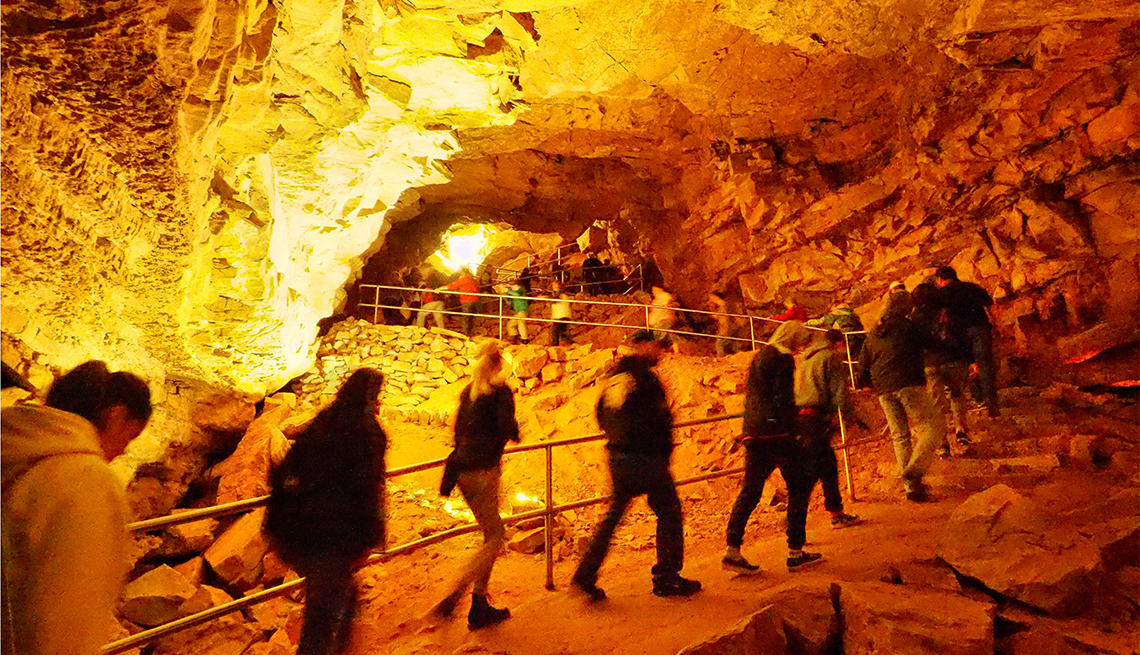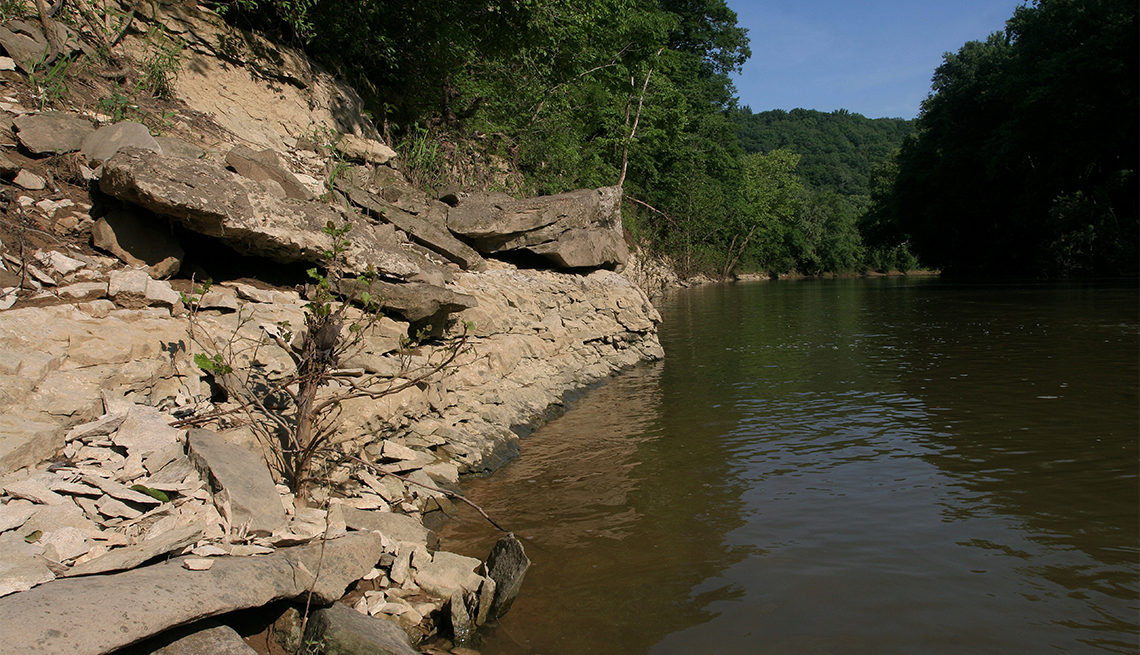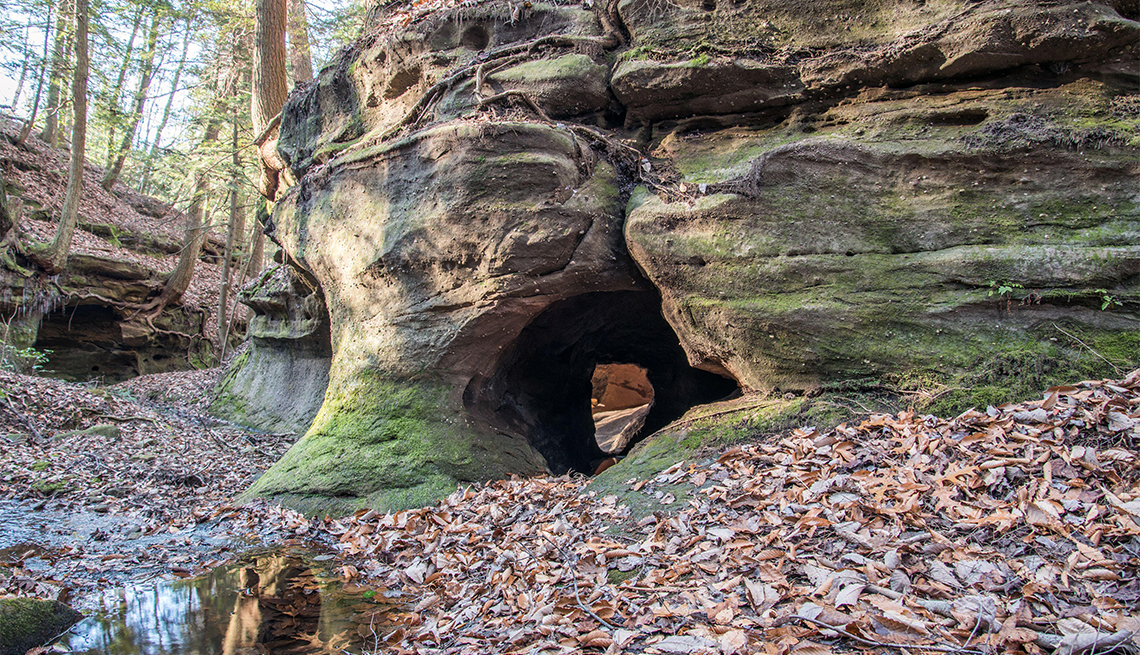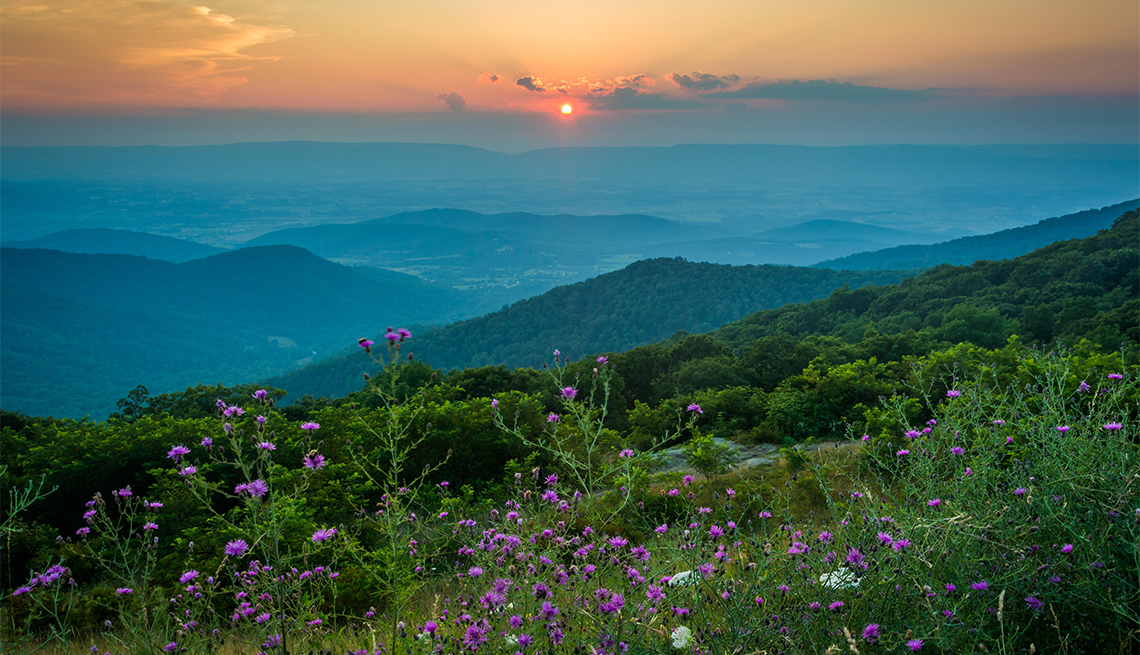AARP's Guide to Mammoth Cave National Park
Explore the natural world above and below ground at this Kentucky treasure
En español | Imagine a national park so complex and, well, mammoth, that no one really knows its true size. Yes, signs mark entrances and exits, but underground, where limestone and water have carved the world's largest cave system (412 miles and still counting), no one knows how vast it is or what will be discovered next. That's the majesty of Mammoth Cave National Park (MCNP) in Central Kentucky. Every time you come back, you can learn about what has been newly discovered and what is better understood about what had been found before.
History is told from inside the underground maze of connected cave passages. Rangers and interpretive materials tell tales from Stephen Bishop, an enslaved man who explored and discovered many new passages and led public tours in the 1800s. Signatures of past visitors written on the rocky walls and ceilings (no, the park doesn't allow that anymore) show the area's long history of tourism. A former subterranean church space retains its sanctuary feel and lantern-made soot markings. Structures used as a former tuberculosis hospital remain. The vast Rotunda shows off old saltpeter mines once used for gunpowder production. The caves’ geology connects all these elements: striped limestone walls, blooming gypsum “flower” formations and small stalagmites and stalactites.
Unlike many other commercial caves, Mammoth Cave is a UNESCO World Heritage Centre, and respects its underground treasure. Some sections do have handrails and lighting, but nothing is hokey or garish. No flashing neon lights or colored water. On the contrary, on some tours, you can experience the caves as early explorers did — in complete darkness or by lantern. You'll learn about wildlife, such as the endangered eyeless cave shrimp, eyeless fish and cave crickets, that thrive on the lack of light and constancy of underground conditions.
Mammoth Cave was a community and a destination long before it became a national park in 1941. Locals created an association to protect the land back in 1926, but as far back as 3,000 B.C. native Americans explored the caves, taking gypsum and other minerals out for their purported medicinal properties. White colonizers discovered these caves in the late 1700s and tried over generations to profit off of them, using them as mines for saltpeter, purported healing hospitals and a geological curiosity.
Eighty percent of the 500,000 people who visit MCNP every year take cave tours, but you can partake in plenty of fun outdoor activities above ground, too. Explore lush green rolling hills, sinkholes, running rivers and scenic overlooks by biking, camping, fishing, hiking, horseback riding, kayaking and more. Its surface areas are rarely overrun, says Molly Schroer, the park's public information officer, so you can enjoy the sounds of nature, not of crowds.
COVID-19 Update
Following a phased reopening plan, most tours are now being offered, but they are modified due to pandemic restrictions. The park strongly recommends that visitors interested in the Extended Historic Cave Tour — the classic tour — make advance reservations for timed entry slots online or by calling 877-444-6777. (There’s no guarantee that walk-up tickets will be available.) The park’s visitor center is open, with limited ranger programs. Note that everyone, regardless of vaccination status, is required to wear a mask inside national park buildings and on all forms of public transportation. Check the park's website for updates.
Plan Your Trip
MCNP is easily reached by car from Nashville (89 miles south) and Louisville (86 miles north), both of which have airports served by multiple airlines. The park is also drivable from Cincinnati (186 miles north) and Indianapolis (203 miles north). You'll find the entrance just 2-1/2 miles off of Interstate 65, so plan to arrive via that route.
Be forewarned that many GPS systems give inaccurate directions to the park, sending visitors on small roads or to the closed Green River Ferry. If coming from the south on I-65, take exit 48 Park City; if coming from the north, take exit 53 Cave City. Good signage on both routes will help you stay on course.
Going underground for a tour means going down several flights of stairs and then coming back up them to exit, so mobility is an issue at MCNP. For that reason, it's important that you check tour descriptions before booking. Plus, some tours have age and size limits and some may require carrying a lantern or crawling. Others are specifically designed for children. Booking tip: When buying tickets, know that this part of Kentucky is on Central Time, as are tour times.
Regardless of the season, weather conditions typically don't impact tours since they're underground: It's usually around 54 degrees inside the caves, whether there's a heat wave or snowstorm outside. So always wear a jacket to explore them — and wear shoes with a nonskid sole to avoid slipping.
In summer, the most popular season to visit, the park offers the most cave tours, and outdoor activities such as canoeing, fishing and kayaking are at their peak in temperatures ranging from a high of 86 to a low of 62. You'll encounter smaller crowds in spring and fall, and you can usually expect pleasant weather, with highs in the 70s and lows in the 40s. Spring rains may cause some flooding that can temporarily limit river access, but foliage thrives on the precipitation. “I really love it here when the spring wildflowers are in bloom, but the entrance to the cave is pretty all year,” says Schroer.
You may have the park practically to yourself in winter, but you'll have fewer tours to choose from and much chillier weather in the 30s and 40s.
A ranger-led talks in the outdoor amphitheater is a good way to get context for the park's varied offerings. The talks cover topics ranging from history to wildflower identification and geology.
Admission to the park is free, and tours range in price from $6-$60. Even if you buy a ticket online, you'll check in at the visitor center near the cave entrance, which has museum-style exhibitions and historical information about the caves and their exploration, as well as a well-stocked gift shop, an outdoor pathway to the lodge and restaurants, ample parking and restrooms. Except in the caves, you should have reliable cellphone service.
Where to Stay and Eat
A convenient location just steps from the park's visitor center, cave tours and trails is the reason to settle into the Lodge at Mammoth Cave. It's not a typical national park-style lodge, but rather a collection of basic hotel rooms (some ADA accessible) and rustic, but comfortable cottages (some with multiple bedrooms) spread out in an inviting woodland area. The rooms all have air conditioning, TVs and Wi-Fi; some cottages have Wi-Fi, but none have TVs or air conditioning. Some cottages permit pets.
The park's three campgrounds are in leafy, shady locales. You'll find 111 campsites (some accessible) at the Mammoth Cave Campground (MCC), within walking distance of the visitor center, and just eight at the more secluded Maple Springs Group Campground, six miles north. Both of these campgrounds accommodate tents and RVs, though each has limited sites with electric and water hookups. (At Maple Springs, visitors can camp with their horses.) None of the 12 tent-only sites at the Houchin Ferry Campground, located 15 miles from the visitor center on the Green River, have hookups, but they have river views. All three have toilet facilities seasonally, and MCC has laundry and showers seasonally, plus an on-site store sells camping essentials. You can reserve sites at all three in advance at recreation.gov, with prices from $7.50 to $50 per night. Mammoth Cave also has two first-come, first-served sites.
For a more rugged camping experience, the park has 13 primitive backcountry campsites accessed only by hiking or horseback.
MCNP's two restaurants are in the lodge. The breakfast buffet at the Green River Grill will give you plenty of fuel for the day. The counter-service-only Spelunkers Café serves breakfast sandwiches and better-than-standard fare (burgers, sandwiches and some vegetarian options) at lunch, with both indoor and outdoor seating. Or just drop by the café for delicious ice cream from a popular local dairy.
The park has six picnic areas in relaxing settings. Look for the largest one, the Mammoth Cave Picnic Area, just north of visitor center parking. It has picnic tables, fire grates, charcoal grills, potable water and restrooms. You can also just find a secluded clearing in a forest.
Things to Do
Go underground. Like most visitors to MCNP, you came to venture down into its caves — and booking a cave tour is the only way to do that. Depending on the time of year, you may have more than a dozen ranger-led tours of varying durations, difficulty and area of focus to choose from.
Experience what it must have been like to discover the caves more than a century ago on the three-hour Violet City Lantern Tour. By lantern light, you'll see outcroppings of rock and walk steeps hills created by both man and nature, as well as petroglyphs more than 2,000 years old. But note: You must traverse 3 miles of steep inclines and declines on uneven dirt paths, with the limited lighting.
The two-hour Accessible Tour covers just 0.5 miles of terrain, none of it with stairs (you'll take an elevator down), but includes some of the caves’ most interesting geological elements. Look up in the large Snowball Room, named for the snowball-shaped calcium carbonate formations on the ceiling.
On the Historic Tour, you'll see displays about geology, sightless fish, saltpeter mines and other uses for the caves over time. Rangers usually lead this 2-mile tour, but it has been temporarily switched to self-guided during the pandemic. Rangers stationed inside tell stories and answer questions, though.
With 412 discovered miles underground, the tours take different routes and don't necessarily overlap, so book more than one — perhaps a tour heavy on history and one that highlights petroglyphs. Buy tickets in advance online to save time and make sure you get a spot, as they do sell out. You'll have more options in the summer, but also more people trying to get tickets at the same time. You'll have less competition in off-season, but also less availability.
Hike. The park has nearly 85 miles of interconnected and overlapping aboveground trails, most of them accessible by both hikers and those on horseback. In addition, mountain bikers can ride on three. Many trails tend to be steep, so always ask about difficulty level before hiking one.
For one of the steeper trails, set out on the Mammoth Cave Railroad Bike and Hike Trail, which follows the historic rail line. The 9-mile (one way), mostly gravel trail starts east of the Green River and winds its way past four cemeteries and a lovely pond, then into a meadow and through densely wooden forest.
On the 1-mile Cedar Sink Loop Trail, get a hint of cave topography without going underground — it leads to a sinkhole where you can see the kind of water that formed the caves. In spring, wildflowers fill the landscape and tree leaves turn red in fall. The walk itself is fairly easy, but 150 stairs lead down to the sinkhole.
The park recently regraded several trails, making them wheelchair-accessible. The mobility impaired will like the easy Echo River Springs Trail, which leaves from near the Green River Ferry. With the construction of a new bridge, the 1.1-mile trail will become a loop walk instead of an out-and-back one. Tactile exhibits and audio panels accommodate the seeing-impaired.
Many of the trails have lovely shade from the summer sun and nice overlooks. Meadows are dotted with wildflowers such as Eggert's Sunflower, a native plant that has been removed from the Endangered Species List because of its recovery in the wild. The 7 miles of trail around the visitor center, cave entrance, lodge and Old Guide's Cemetery have fewer inclines and more benches and places to rest.
The bulk of the park's trails (60 miles) are in the backcountry and perfect for horseback riding, a popular Mammoth Cave activity. Sign up for a guided trail ride at Double J Stables, just outside the park's northeast corner, and spend from one to two hours seeing the park from a saddle.
Paddle. Go canoeing or kayaking on the Green and Nolin rivers, which run through the park. Even on hot summer days, the rivers’ spring-fed water stays cool — usually between 72 and 75 degrees — making for a refreshing swim if you take a paddling break, says Suzanne Ochoa, Cave Country Canoe manager. Paddling adventures offered by Ochoa's company and Green River Canoeing vary in length, from three hours to two-day excursions, with senior discounts available.
The Green River, a wide river without rapids, has lots of islands where you can stop and rest. The narrower Nolin has fewer stopping points. When its water level is high, you can do a round-trip paddle (heading back upstream). “We have a lot of seniors, people in their 50s to their 70s, come out for that reason,” says Ochoa.
Fish. Do some casting in either river in hopes of reeling in bass, bluegill, catfish or muskie. Many Cave City and Park City shops stock bait and basic gear. You don't need a fishing license in the park, but there are catch limits.
AARP Membership -Join AARP for just $15 for your first year when you enroll in automatic renewal
Join today and save 25% off the standard annual rate. Get instant access to discounts, programs, services, and the information you need to benefit every area of your life.
Gateway Towns
The small towns of Cave City (10 miles southeast of the park) and Park City (9 miles south) support park goers with fun attractions for keeping grandkids entertained, finding essentials that you forgot to pack, buying souvenirs and connecting with outfitters for outdoor excursions. In Cave City, give the kiddos a thrill at Dinosaur World, with its life-sized replicas of the large reptiles; and buy rocks, fossils and minerals at Big Mike's Rock Shop.
Two larger cities with less kitsch and more culture lie just a bit farther away.
In Bowling Green, 23 miles southwest of the park, take in Broadway-style plays and national musical acts at the Southern Kentucky Performing Arts Center, a plush amphitheater. The space also houses visual-art galleries worth seeing when you're at the center for a show. Dine alongside locals at Mariah's, a downtown favorite for more than three decades. Try the bacon-wrapped salmon or a brick-oven pizza. For some shut-eye, check into one of the city's reliable chain hotels, such as Home2 Suites and Tru by Hilton.
In Glasgow, 21 miles southeast of the park, spend an entertaining evening at the Plaza Theatre, a restored 1934 music venue with eye-popping Mediterranean architecture. Originally built for vaudeville acts, it now hosts Americana, folk and other musical acts.
Historic homes, several now operating as B&Bs, dot the town. Hall Place Bed and Breakfast does everything in style and is within walking distance of downtown and its quaint preserved streets, where you can eat at locally owned barbecue, Italian and Mexican restaurants.
En Route
If you're coming from the north, stop in Louisville. Its connections to the sports world (think horse racing, baseball-bat making and boxing) and bourbon-making define what you'll want to do here. At the Louisville Slugger Museum and Factory, tour the facility that has been manufacturing baseball bats since 1884. Also, sample Kentucky's famed whiskey on a distillery tour. Leave the driving to someone else on a guided tour with Mint Julep Experiences. You'll make select stops along the Kentucky Bourbon Trail, a collection of distilleries throughout the state. If you want to stay overnight, settle into the Brown Hotel, a city landmark since 1923, for some boxing nostalgia — the property is chock-full of artifacts from hometown boxing legend Muhammad Ali, including a set of his prize-winning gloves. At the hotel's restaurant, sink your teeth into its signature dish, the Hot Brown, an open-faced turkey sandwich with bacon and cheese, a variation on Welsh rarebit. Visitor tip: To sound like a local, pronounce the city's name correctly: It's “Lou-ah-vul,” not “Louis-ville."
From the south, spend time in Nashville, catching a country-music show at the Grand Ole Opry and delving deep into the genre at the Country Music Hall of Fame and Museum. Or visit the Johnny Cash and Patsy Cline museums, both jam-packed with artifacts but small enough to explore and learn without being overwhelmed. Stay at the Russell, an East Nashville boutique hotel in a renovated church with jaw-dropping stained-glass windows in the lobby. Hotel profits benefit local homeless advocacy groups, so your night's stay helps others find somewhere to sleep.
- |
- Photos
Editor's note: This article was originally published on October 23, 2020. It's been updated to reflect recent COVID-19 developments.


